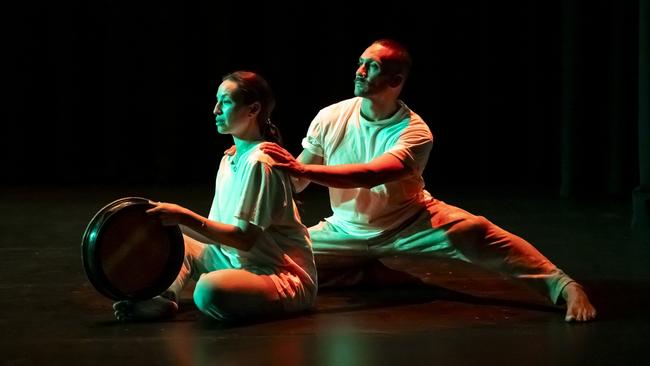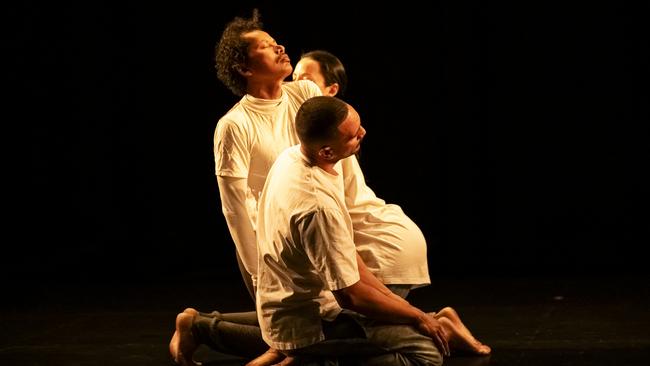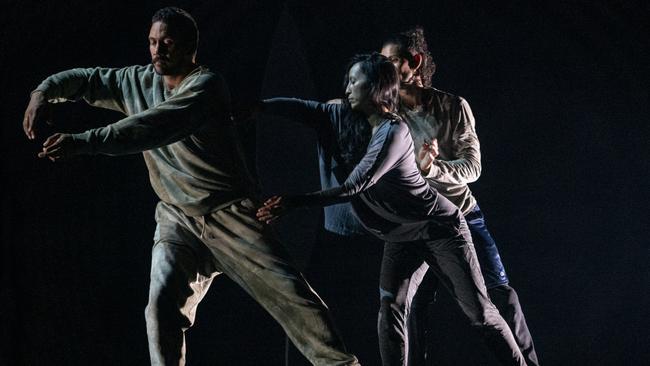Regional kinships unearthed in Asian-Indigenous contemporary dance
What happens when you put virtuoso dancers and choreographers in a dance lab with a Bluey engineer, feminist horror filmmaker and contemporary visual artists?

Raymond Blanco was in the midst of researching his family history — one that extends from the Philippines and Indonesian Borneo, down through the Torres Strait and Cape York to Innisfail — when the celebrated choreographer received an irresistible invitation.
Indigenous contemporary dance producer BlakDance was pulling together an ensemble of acclaimed artists that mirrored his own sprawling ancestral roots, and wanted him to help steer it.
The idea was to create a dance piece exploring the fine threads connecting those disparate cultures over millennia for AsiaTOPA, the triennial Asia Pacific Melbourne arts festival, beginning this week, whose mandate of drawing regional cultures together seems especially timely in an era of rising geopolitical competition.
The collective could not have been more diverse; from acclaimed visual artist Vernon Ah Kee, ex-Bangarra dancers Waangenga Blanco and Tyrel Dulvarie to an Indonesian Australian horror filmmaker, a Bluey editor, an Indian Australian choreographer and Indonesian Australian Suara dance group.
But the creative process was a revelation for all, uncovering similarities in traditional movement, language and cultural rules that underpin a strikingly contemporary performance.
Anthropologists have been steadily uncovering deep links between Australia’s First Nations people and Southeast Asian communities, through trade, cultural exchange and intermarriages, that long predate colonial settlement.

Annual visits by Makassan sea cucumber fishermen to the north coast of Australia dating back to the 1600s sparked cross-cultural exchanges and romances that were only curtailed by the Australian government in 1907.
But the cultural links embedded from such exchanges are only now being unearthed.
Raymond Blanco says the creative process behind Bunyi Bunyi Bumi (Sound of the Earth) — that debuts this week at Bunjil Place in Melbourne’s multicultural heart of Narre Warren — has helped him pull together pieces of his own story.
“I always felt like a tourist inside indigenous communities,” he tells The Australian of his rich, mixed heritage.
“I realise it’s not a unique story but one that a lot of Aboriginal people share across the north. This show for me has opened doors … to explore deeper the forms of Torres Strait Island music and rhythm.”
Beyond mainstream Torres Strait Islander pop star Christina Anu, Blanco says there has been little focus on that region’s music and dance culture “so this is a way for me to move forward”.
Indonesian Australian dancer Alfira Sullivan — one of three performers featured — sees the collaboration not only as an avenue for rebuilding historic connections disrupted by colonialism, but a way of up-ending sometimes myopic industry interpretations of what constitutes contemporary performance. The broad ensemble is gloriously free of such cultural demarcation, bringing in Katrina Irawati Graham from her recent Bali 2002 film for Stan to dramaturg her first dance project with Malaysian Australian artist Govin Ruben, and engaging Ah Kee as “visual designer”.

“Everybody has an individual story they’re telling, but they’re interwoven,” says Priya Srinivasan, a Tamil dance academic and co-director of the show that brings together Waangenga’s powerful physicality and contemporary dance virtuosity with the more controlled intricacies of Indonesian and Indian dance traditions.
“The bigger question, is how do we connect?” In Bunyi Bunyi Bumi that connection is made through a seamless contemporary blend of Acehnese body percussion, Indonesian song, Tamil and Aboriginal and Torres Strait Islander dance — artistic tools from communal cultures through which individual stories are told.
For Acehnese dancer Murtala, it is his experience of pulling bodies from the post-tsunami apocalypse of his home town Banda Aceh, while Waangenga and Alfira’s stories are of personal dislocation and the solace that comes from shared kinships across the Asia-Pacific.
The show, commissioned especially for the AsiaTOPA Festival, makes its global debut at Melbourne’s Bunjil Place theatre from February 20 to 23.







To join the conversation, please log in. Don't have an account? Register
Join the conversation, you are commenting as Logout